Click on thumbnail
for full size image |
Size |
Image Description |
Source |
SS Vaterland
|
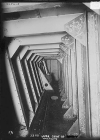 |
75k |
|
Tommy Trampp |
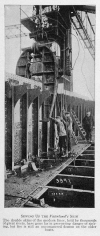 |
84k |
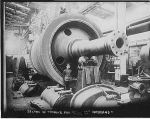 |
144k |
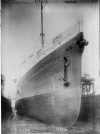 |
54k |
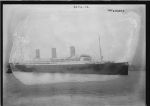 |
52k |
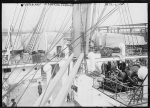 |
98k |
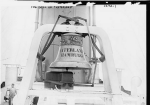 |
52k |
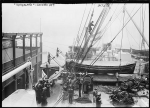 |
88k |
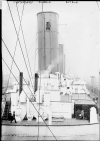 |
61k |
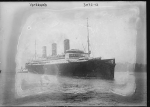 |
58k |
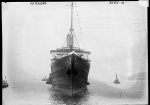 |
51k |
 |
159k |
Undated post cards |
 |
61k |
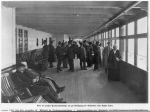 |
113k |
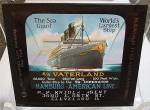 |
52k |
Advertising Color Magic Lantern Glass Slide
Made by Harold Ivers Company, Metropolitan Life Building, New York |
 |
343k |
Photo from "Passenger Liners of the World Since 1893" (1979) by Nicholas T. Cairis |
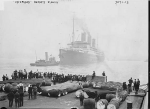 |
61k |
26 May 1914 |
Tommy Trampp |
 |
369k |
29 July 1914
Arriving at New York City
Photo from "A History Of The Transport Service: Adventures And Experiences Of United States Transports And Cruisers In The World War", by Vice Admiral Albert Gleaves, USN, Published by George H. Doran Company, New York |
Robert Hurst |
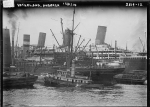 |
91k |
11 December 1914
Hoboken, NJ |
Tommy Trampp |
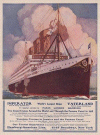 |
93k |
c. 1915 |
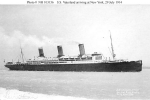 |
83k |
Arriving at New York City on 29 July 1914, three days before Germany's declaration of war on Russia began World War I.
Courtesy of the Naval Historical Foundation, Washington, D.C. Collection of Captain Cyrus R. Miller, USN.
U.S. Navy photo NH 103156 |
Naval Historical Center |
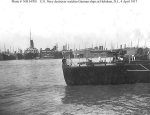 |
121k |
Interned at their piers at Hoboken, New Jersey, on 4 April 1917, two days before the United States declared war on Germany. In the foreground is the stern of a U.S. Navy destroyer, which is keeping watch on the ships. The piers are those of the Hamburg-America Line (left center) and the North German Lloyd Line (right center). The large ship at left is S.S. Vaterland. The four-funneled liner in right center is probably S.S. Kaiser Wilhelm II (later USS Agamemnon [ID-3004]).
U.S. Navy photo NH 54700 |
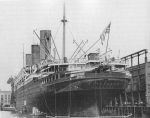 |
118k |
Vaterland tied up at her New York pier, on 8 April 1917, the day after her seizure by the U.S. government
National Archives photo from "Great Liners at War" by Stephen Harding |
Robert Hurst |
USS Leviathan (ID 1326)
|
 |
90k |
. |
Joe Radigan |
 |
79k |
Troops taking the air |
Tommy Trampp |
 |
76k |
At anchor with two unknown tugs alongside. She is painted in a dazzle color scheme prepared by Norman Wilkinson's Admiralty team.
National Archives photo 13431 from "Naval Camouflage 1914-1945: A Complete Visual Reference" by David Williams |
Robert Hurst |
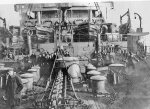 |
155k |
Doughboys and blue jackets shelter from the wind on Leviathan's foc'sle during a winter crossing
Naval History and Heritage Command photo from "Great Liners at War" by Stephen Harding |
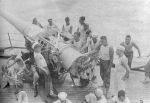 |
101k |
The crew of one of Leviathan's 6" guns as they take a break near their weapon, surrounded by fellow blue jackets. The ship was armed with eight of these weapons: four forward, two aft and two amidships. Only the forward and aft mounts had splinter shields, though all eight guns had ready-ammunition lockers fitted to the deck close at hand
Naval History and Heritage Command photo from "Great Liners at War" by Stephen Harding |
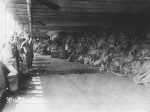 |
116k |
Members of her crew standing opposite one of the many mounds of life jackets discarded by disembarking troops. Even after the Armistice embarked personnel were sometimes ordered into life jackets as the ship approached port, primarily as a precaution in case the troopship collided with another vessel or hit a rogue mine
National Archives photo from "Great Liners at War" by Stephen Harding |
 |
117k |
Undated post card showing her Flying Bridge |
Tommy Trampp |
 |
336k |
Transporting U.S. troop to France
Photo from "A History Of The Transport Service: Adventures And Experiences Of United States Transports And Cruisers In The World War", by Vice Admiral Albert Gleaves, USN, Published by George H. Doran Company, New York |
Robert Hurst |
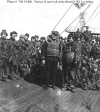 |
113k |
Nurses aboard the transport pose in rubber survival suits, during a World War I Atlantic crossing. The Navy officer with them is wearing a life vest
Naval History and Heritage Command photo NH 51406 |
 |
127k |
Metal model of Leviathan is detailed and made by fine German Model Makers CM |
Tommy Trampp |
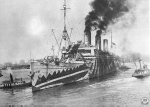 |
81k |
Steaming out of New York in wartime camouflage, probably 1917
U.S. Navy photo |
Joe Radigan |
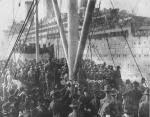 |
137k |
Departing New York for France, on 15 December 1917, cheered on by troops and nurses packed aboard a smaller vessel
National Archives photo from "Great Liners at War" by Stephen Harding |
Robert Hurst |
 |
87k |
Oil painting by Burnell Poole, depicting USS Allen (Destroyer No. 66) escorting Leviathan in the War Zone, 1918.
The original painting measures 60" x 33"
Courtesy of the Naval Historical Foundation, Washington, D.C.
U.S. Navy photo NH 42690-KN |
Naval Historical Center |
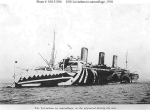 |
115k |
Halftone reproduction of a photograph showing the ship moored to a buoy in 1918. She is painted in "dazzle" camouflage.
The original photograph was taken by Enrique Muller, New York
U.S. Navy photo NH 51396 |
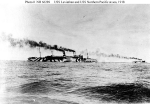 |
129k |
Underway at sea, 1918. The ship in the right distance is USS Northern Pacific.
Courtesy of Donald M. McPherson
U.S. Navy photo NH 66289 |
 |
104k |
In harbor, while painted in "dazzle" camouflage, 1918. The original photograph was captioned "The Queen of Them All", a reference to Leviathan's status as the then largest ship in
the World.
Collection of James J. Clerkin Sr.
Naval Historical Center photo NH 103165 |
Robert Hurst |
 |
84k |
At sea in 1918.
Courtesy of Jack Howland, 1987.
Naval Historical Center photo NH 101625 |
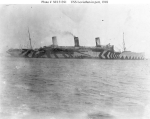 |
105k |
In port, while painted in "dazzle" camouflage in 1918, probably at Brest, France.
Photographed by Zimmer.
Naval Historical Center photo NH 51391 |
 |
70k |
Photographed from USS Warrington (Destroyer No. 30), 1918.
Courtesy of Gustavus C. Robbins, 1973.
Naval Historical Center photo NH 77161. |
 |
80k |
Photographed in 1918. The destroyer in the right foreground may be USS Downes (Destroyer No. 45), which had a similar (though not identical) camouflage scheme
Courtesy of Jack Howland, 1981.
Naval Historical Center photo NH 92952. |
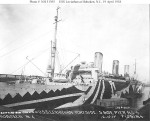 |
137k |
At Pier Number 4, Hoboken, New Jersey, 19 April 1918. She is painted in "dazzle" camouflage. The covered lighter alongside the ship is marked (faintly) "U.S. Navy Provisions &
Clothing Depot"
Photographed by the New York Navy Yard
Naval Historical Center photo NH 51395 |
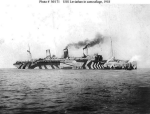 |
108k |
In harbor, with tugs in attendance at her starboard bow, 1918
Naval Historical Center photo NH 71 |
 |
104k |
Passing a light ship while at sea in 1918. A destroyer is in the left background.
Naval Historical Center photo NH 43284 |
 |
102k |
In a busy harbor, while wearing "dazzle" camouflage, 1918. A small vessel towing a "kite" balloon is just to right of Leviathan's bow, and the many camouflaged ships present. Location may be Brest, France.
Donation of Charles R. Haberlein Jr., 2007
Naval Historical Center photo NH 105107 |
 |
105k |
In New York Harbor, 1918, with a tug steaming by on the right and a battleship in the left background.
Photographed by E. Muller Jr., 198 Broadway, New York City
Donation of Charles R. Haberlein Jr., 2007
Naval Historical Center photo NH 105389 |
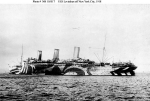 |
127k |
In New York Harbor, 1918, while painted in "dazzle" camouflage.
Photographed by E. Muller Jr., 198 Broadway, New York City
Donation of Charles R. Haberlein Jr., 2008
Naval Historical Center photo NH 105517 |
 |
127k |
Drydocked at Liverpool, England, in the spring of 1918. She is partially repainted in the "dazzle" camouflage scheme she carried for the rest of World War I.
Donation of Dr. Mark Kulikowski, 2008
Naval Historical Center photo NH 105518 |
 |
99k |
Henderson (Transport No. 1), at left, and Leviathan, center, photographed circa May 1918, probably at Brest, France. They were members of a convoy escorted by USS Wakiva
(SP-160), from which this photograph was presumably taken. Wakiva was lost in a collision on 22 May 1918. Both ships are wearing "dazzle" camouflage
Courtesy of James A. Turner, Jr., from the collection of Samuel A. Turner, Jr., who served in Wakiva during World War I
Naval History and Heritage Command photo NH 105585 |
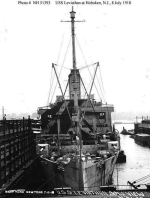 |
143k |
Docked at Hoboken, New Jersey, on 8 July 1918, while painted in "dazzle" camouflage
Photographed by the New York Navy Yard
Naval Historical Center photo NH 51393 |
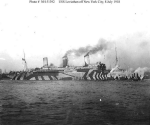 |
108k |
In New York Harbor, attended by several tugs on 8 July 1918.
Photographed by the New York Navy Yard.
Courtesy of Donald M. McPherson.
U.S. Navy photo NH 51392 |
Naval Historical Center |
 |
69k |
Leaving New York City carrying nearly 14,500 persons, including troops and ship's personnel, circa July 1918. In the foreground is the cruiser USS New Orleans, which was at anchor at
Thompkinsville, N.Y.
Courtesy of Captain Edgar B. Larimer, USN, 1931. He was New Orleans' Commanding Officer at the time this photograph was taken.
Naval Historical Center photo NH 1096 |
Robert Hurst |
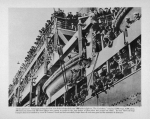 |
193k |
c. 1918
Arriving at Brest, France
U.S. Army Signal Corps photo |
Tommy Trampp |
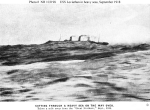 |
131k |
Halftone reproduction of a photograph taken from USS Northern Pacific as both ships were steaming through heavy seas en route to France during September 1918. This image was published in 1919 by the National Specialties Company of New York City, as one of ten photographs in a "Souvenir Folder" of views concerning USS Leviathan
Donation of Dr. Mark Kulikowski, 2005
U.S. Navy photo NH 103198 |
Naval Historical Center |
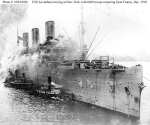 |
144k |
Steaming up the North River, New York City, on her way to her pier with 8,000 troops on board who are returning home from France, 16 December 1918. Tugs alongside indicate that the ship is moving into her berth
Courtesy of San Francisco Maritime Museum, San Francisco, California, 1969
Naval History and Heritage Command photo NH 69056 |
Robert Hurst |
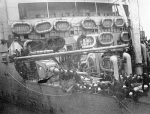 |
150k |
A close-up of some of the sailors returning from duty in France crowd around one of the starboard forward 6" mounts for a better view of the docking, on 16 December 1918. Note that several of the life rafts suspended from the ship's forward superstructure had been painted as part of the overall dazzle scheme. Though the majority of the ship's hull was by now overall grey, parts of her upper works retained traces of the dazzle scheme
Naval History and Heritage Command photo from "Great Liners at War" by Stephen Harding |
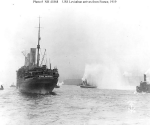 |
86k |
Arriving at New York after a voyage across the Atlantic from France, 1919
Naval Historical Center photo NH 41868 |
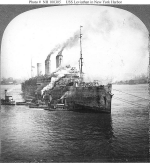 |
111k |
In New York Harbor, with tugs assisting her into her berth, circa late 1918 or 1919.
Photo printed on a stereograph card, copyrighted by Underwood & Underwood and published by the Keystone View Company.
Donation of Louis Smaus, 1985
U.S. Navy photo NH 100305 |
Naval Historical Center |
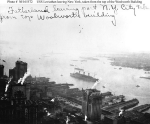 |
121k |
Photographed from the top of the Woolworth Building, New York City, while departing for a trans-Atlantic voyage in 1918-1919
Courtesy of Mrs. Mabel Croft Graham, 1968
Naval History and Heritage Command photo NH 65572 |
Robert Hurst |
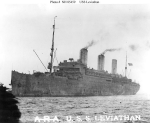 |
107k |
Photographed circa late 1918 or in 1919
Courtesy of Donald M. McPherson, 1977
Naval History and Heritage Command photo NH 85459 |
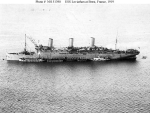 |
165k |
At Brest, France, with harbor craft alongside, circa early 1919
Naval History and Heritage Command photo NH 51390 |
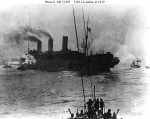 |
133k |
Photographed in 1919. She is probably arriving in New York Harbor from France, bringing service personnel home from the former World War I combat zone
Photographed by the Navy's Bureau of Navigation
Naval History and Heritage Command photo NH 51397 |
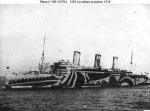 |
140k |
At anchor, circa mid- or late-1919, while wearing "dazzle" camouflage.
Donation of Charles R. Haberlein Jr., 2008
Naval Historical Center photo NH 105764 |
 |
108k |
In New York Harbor, with the Manhattan skyline in the background, 1919
Photographed by E. Muller Jr., 198 Broadway, New York City
Donation of Charles R. Haberlein Jr., 2007
Naval Historical Center photo NH 105176 |
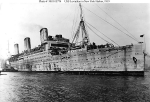 |
150k |
In New York Harbor (probably Hoboken, New Jersey), 1919
Donation of Charles R. Haberlein, Jr., 2008
Naval Historical Center photo NH 105774 |
 |
130k |
Entering New York Harbor in March 1919, with 8,000 troops of the 27th Division on board
Photographed by Enrique Muller, Jr., New York
Courtesy of Harold B. Feile, 1970
U.S. Navy photo NH 70166 |
Naval Historical Center |
 |
135k |
In New York Harbor, March 1919, crowded with troops returning from France. She is accompanied by several tugs, an ambulance boat, and (alongside her bow) what appears to be
USS SC-412
Photographed by E. Muller Jr., New York
Naval Historical Center photo NH 105192 |
Robert Hurst |
 |
104k |
Arriving in New York Harbor while bringing troops home from France, probably in March 1919. She has an honors escort of local arbor steamers. The Statue of Liberty is in
the distance.
Photographed by N. Moser, New York City
Naval Historical Center photo NH 105390 |
 |
143k |
Entering New York Harbor, accompanied by many smaller vessels, 1919. The general appearance of celebration indicates the ship is arriving from France, with service personnel on board, possibly in March 1919. Photographed from Hudson Terminal
Courtesy of Harold B. Feile, 1970
Naval History and Heritage Command photos NH 71159 and NH 71160 |
 |
151k |
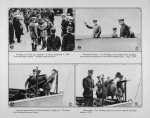 |
154k |
c. September 1919
General Pershing departing France and returning to the United States
U.S. Army Signal Corps photo |
Tommy Trampp |
 |
111k |
USS Imperator (ID 4080), at left, and Leviathan at Hoboken, New Jersey, probably after Imperator's first trans-Atlantic voyage as a U.S. Navy ship, circa late May 1919. At that time, these were the World's largest ships, hence the photo's title: "The 'Giants' of the Sea".
Panoramic photograph by Picot, 15 4th Avenue, Brooklyn, New York.
Donation of Georgia Adams Grann and Caryl L. Adams, 2005. The original print came from the collection of their father, George W. Adams, who enlisted in the Navy in 1908.
U.S. Navy photo NH 103126. |
Naval Historical Center |
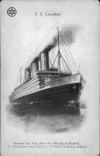 |
60k |
Post card dated 20 May 1919 |
Tommy Trampp |
 |
86k |
Back of post card |
 |
234k |
Ship's Officers and Crew pose on her foredeck, at Hoboken, New Jersey, 14 July 1919. The ship's Commanding Officer, seated in the front row immediately to the right of the anchor chain in center, is Captain Edward H. Durell, USN. Seven nurses are present in the second row, to left and right of the center
Donation of Dr. Mark Kulikowski, 2007
Panoramic photograph ©by Hughes & Estabrook, 251 West 42nd Street, New York City
Naval History and Heritage Command photo NH 104684 |
Robert Hurst |
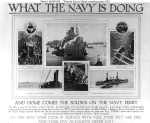 |
321k |
Poster from the "What the Navy is Doing" series, published by the Navy Recruiting Bureau, New York, 1919. It depicts U.S. Navy ships transporting Army personnel home from the European war zone after the end of World War I, with text emphasizing the advantages to former Soldiers of enlisting in the Navy. Leviathan is featured in the center of the poster
National Archives photo 80-WP-992 |
SS Leviathan
|
 |
215k |
Undated post card
© Ed. Levick, NY |
Tommy Trampp |
 |
91k |
Undated post cards |
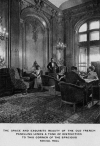 |
88k |
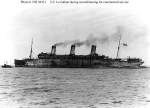 |
115k |
Photographed in April 1922, while en route to Newport News, Virginia, to be reconditioned for commercial service
Courtesy of the Naval Medical Command Archives, 1983
Naval History and Heritage Command photos NH 94331, NH 94332 and NH 94333 |
Robert Hurst |
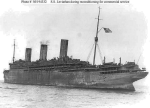 |
100k |
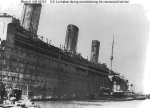 |
115k |
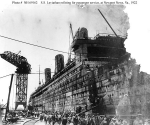 |
179k |
Original photo: At Newport News, Virginia, shipyard workers pour from the vessel in response to the noon whistle. During her year-long, $8 million refurbishment Leviathan was converted to oil fuel and returned to her full pre-war splendor
Naval History and Heritage Command photo from "Great Liners at War" by Stephen Harding
Replacement photo: Workmen leaving the ship for lunch on 15 June 1922, while she was being refitted for commercial service at the Newport News Shipbuilding and Dry Dock Company shipyard, Newport News, Virginia
Courtesy of the San Francisco Maritime Museum, San Francisco, California, 1969
Naval History and Heritage Command photo NH 69162 |
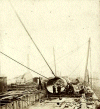 |
97k |
Amidships deck view, looking forward
Photo by Robert Howlett and George Downes |
Tommy Trampp |
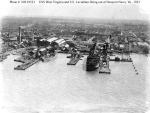 |
165k |
Aerial photograph of Newport News Shipbuilding and Dry Dock Company shipyard's, pier area, February 1923. USS West Virginia (BB-48) is fitting out in the left center. In right center is Leviathan, refitting for commercial service
Naval History and Heritage Command photo NH 93533 |
Robert Hurst |
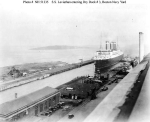 |
117k |
Entering Dry Dock Number 3, Boston Navy Yard, Massachusetts, during the 1920s
Naval History and Heritage Command photo NH 51335 |
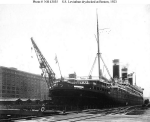 |
109k |
In drydock at Boston, Massachusetts, in 1923. She is undergoing preparations for her maiden voyage under the United States Lines flag, which commenced on 4 July of that year
Naval History and Heritage Command photo NH 43035 |
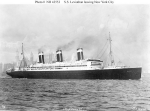 |
111k |
Steaming out of New York Harbor, circa the mid-1920s. The Manhattan skyline is in the background.
U.S. Navy photo NH 43553 |
Naval Historical Center |
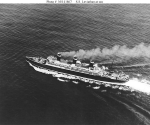 |
143k |
Photographed from an aircraft, while underway at sea during the 1920s or 1930s.
U.S. Navy photo NH 41867 |
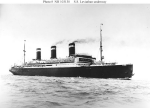 |
74k |
Underway during the 1920s or 1930s, probably in French waters.
U.S. Navy photo NH 103130 |
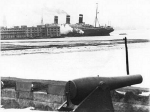 |
39k |
c. 1930
Boston, MA |
Tommy Trampp |
 |
256k |
7 April 1930
Boston, MA
|
Edward Russo |
 |
271k |
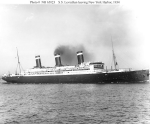 |
116k |
Leaving New York Harbor, 21 July 1934
Donation of Franklin Moran, 1967
U.S. Navy photo NH 65023 and NH 65024 |
Naval Historical Center |
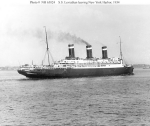 |
113k |
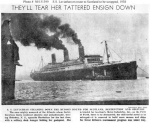 |
147k |
Halftone reproduction from a contemporary newspaper, showing the ship steaming down the Hudson River, off Hoboken, New Jersey, in 1938, bound for Scotland to be scrapped. Its title, "They'll Tear Her Tattered Ensign Down" is a reference to Oliver Wendell Holmes' poem opposing the proposed scrapping of USS Constitution in 1830.
International News Photo
Courtesy of CWO2 John A. Steel, USN.
U.S. Navy photo NH 51399 |